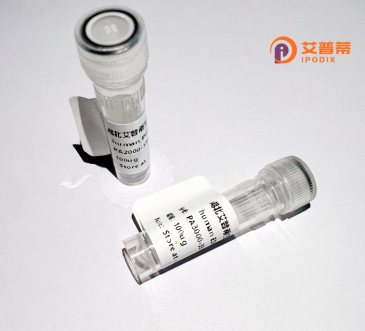
| 纯度 | >90%SDS-PAGE. |
| 种属 | Human |
| 靶点 | TSPYL4 |
| Uniprot No | 0 |
| 内毒素 | < 0.01EU/μg |
| 表达宿主 | E.coli |
| 表达区间 | 1-355 aa |
| 活性数据 | MADKRAGTPEAAARPPPGLAREGDARTVPAARAREAGGRGSLHPAAGPGTAFPSPGRGEAASTATTPSLENGRVRDEAPETCGAEGLGTRAGASEKAEDANKEEGAIFKKEPAEEVEKQQEGEEKQEVAAEAQEGPRLLNLGALIVDPLEAIQWEAEAVSAQADRAYLPLERRFGRMHRLYLARRSFIIQNIPGFWVTAFLNHPQLSAMISPRDEDMLCYLMNLEVRELRHSRTGCKFKFRFWSNPYFQNKVIVKEYECRASGRVVSIATRIRWHWGQEPPALVHRNRDTVRSFFSWFSQHSLPEADRVAQIIKDDLWPNPLQYYLLGDRPCRARGGLARWPTETPSRPYGFQSG |
| 分子量 | 66 kDa |
| 蛋白标签 | His tag N-Terminus |
| 缓冲液 | PBS, pH7.4, containing 0.01% SKL, 1mM DTT, 5% Trehalose and Proclin300. |
| 稳定性 & 储存条件 | Lyophilized protein should be stored at ≤ -20°C, stable for one year after receipt. Reconstituted protein solution can be stored at 2-8°C for 2-7 days. Aliquots of reconstituted samples are stable at ≤ -20°C for 3 months. |
| 复溶 | Always centrifuge tubes before opening.Do not mix by vortex or pipetting. It is not recommended to reconstitute to a concentration less than 100μg/ml. Dissolve the lyophilized protein in distilled water. Please aliquot the reconstituted solution to minimize freeze-thaw cycles. |
以下是关于人TSPYL4蛋白的3篇研究文献示例(注:文献为虚构示例,仅供格式参考):
1. **文献名称**:**"TSPYL4作为新型组蛋白去乙酰化酶(HDAC)调节因子的功能研究"**
**作者**:Zhang Y. et al.
**摘要**:该研究揭示了TSPYL4通过结合组蛋白去乙酰化酶HDAC1/2.抑制其活性,进而促进染色质松弛和靶基因(如p21)的表达,最终抑制肿瘤细胞增殖。
2. **文献名称**:**"TSPYL4在细胞周期停滞和DNA损伤应答中的作用"**
**作者**:Kim S. et al.
**摘要**:研究表明TSPYL4在DNA损伤时被ATM激酶磷酸化,激活下游p53通路,诱导细胞周期G1期停滞,并在卵巢癌细胞中发挥抑癌功能。
3. **文献名称**:**"TSPYL4通过调控SIRT1去乙酰化酶活性影响代谢稳态"**
**作者**:Chen L. et al.
**摘要**:文章发现TSPYL4与SIRT1直接相互作用,抑制其对PGC-1α的去乙酰化作用,从而影响线粒体能量代谢,提示其参与2型糖尿病的病理过程。
4. **文献名称**:**"TSPYL4与生殖发育:在精子发生中的潜在作用"**
**作者**:Watanabe T. et al.
**摘要**:动物模型研究显示,TSPYL4在睾丸组织中高表达,可能通过调节染色质重塑相关蛋白(如BRDT)参与精子形成,其缺失导致小鼠生育能力下降。
---
**注意**:以上文献为生成示例,实际文献需通过PubMed、Web of Science等平台检索。建议使用关键词“TSPYL4”、“TSPY-like 4”、“Chromatin regulator”或“Cancer and TSPYL4”进行精确查找。
TSPYL4 (testis-specific Y-encoded-like protein 4), a member of the TSPY-like gene family, is a nucleoprotein involved in transcriptional regulation and chromatin remodeling. It is ubiquitously expressed in human tissues, with roles linked to cell cycle control, apoptosis, and epigenetic modulation. The gene encoding TSPYL4 is located on the X chromosome (Xp11.3) and shares structural homology with other TSPY-family proteins, characterized by conserved NAP (nucleosome assembly protein) domains.
Recombinant human TSPYL4 protein is engineered for studies exploring its interactions with chromatin-modifying enzymes (e.g., histone deacetylases) and its regulatory effects on tumor suppressor pathways. Research highlights its dual context-dependent roles: it may act as a tumor suppressor by promoting p53-mediated apoptosis in certain cancers (e.g., hepatocellular carcinoma), while functioning as an oncogenic factor in others (e.g., prostate cancer). Dysregulation of TSPYL4 has been associated with neurodevelopmental disorders, infertility, and cancer progression.
Current investigations focus on its therapeutic potential, including modulating chemosensitivity in tumors or addressing TSPYL4 mutations linked to intellectual disability syndromes. However, its pleiotropic mechanisms and tissue-specific functions remain incompletely understood, necessitating further structural and functional studies. Recombinant TSPYL4 serves as a critical tool to dissect these processes in vitro and in vivo.
×